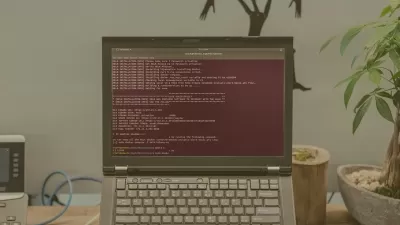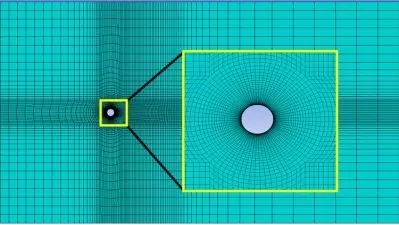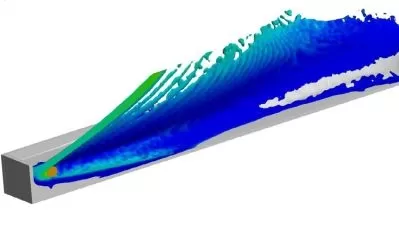CFD analysis of backward facing step (BFS) and validation
Sijal Ahmed
3:56:56
Description
Backward facing step CFD analysis and validation at Re = 100 and expansion ratio 1.9423
What You'll Learn?
- Validation of well know test case
- CFD analysis of separated flows
- Finding out reattachment length using CFD
- Velocity profile for channel flow and UDF for implementing it
- Solving same case using three different methods
Who is this for?
More details
DescriptionIn CFD analysis validation and verification are two important aspects for high quality results. Verification assessment determines if the programming and computational implementation of the conceptual model is correct. It examines the mathematics in the models through comparison to exact analytical results. Verification assessment examines for computer programming errors. On the other hand Validation assessment determines if the computational simulation agrees with physical reality. It examines the science in the models through comparison to experimental results. While
Therefore in this course we are going to validate our results with corresponding experimental data from well know published data on backward facing step. This will show students that how much our simulation is close to actual data and builds confidence in them for other cases they wish to take in their academic or professional career.
Backward facing step is well know test case f or the validation of CFD solvers for couple of decades. In this particular course we have examined the backward facing step at Reynolds number (based on hydraulic diameter) = 100 and expansion ratio H/h = 1.9423 (B f armaly 1983) and compared reattachment length downstream of step. We have found that the results are matching very well with experimental data.
In the present course, I am providing you with three methods or way to conduct CFDÂ analysis. You can learn all three or any one based on your preference and time you want to spend in learning CFDÂ analysis of backward facing step. Before that I have alos given complete explanation of problem including how to get flow and fluid properties and corresponding experimental results from research papers. I have also explained the velocity profile used in the CFDÂ simulation and how to compile that velocity profile using UDFÂ in Fluent. Even the analytical derivation of velocity profile is also given in this course.
1. Using ICEMCFD and Fluent in stand alone mode. This is the most professional way to solve CFD simulation. You will have full control meshing process specially hexa meshing in ICEMCFD. And file management will also be according to your choice. But file transfers will be manual which can ad some extra work. This section has more explanation of every thing as compared to other sections. I would recommend this section if you really want to excel. You will also learn tecplot for CFD processing.
2. Using workbench. In this section you will create geometry in design modeler, meshing in workbench mesher and CFDÂ in Fluent. Fluent part will be almost similar to section 1 but it contain less explanations. Geometry and meshing will be simple to create. We don't have much control on meshing process though. But advantage is that it is more straightforward. File transfer is automatic. Recommended for those who don't want to go for ICEMCFDÂ or more details.
3. Most simple section to follow. As it uses already created mesh and just solves case in Fluent. Explantions are to be the point and are minimal. Follow this section if you dont to create mesh and geometry by yourself.
Note : Section 2 and 3 can be solved using ANSYSÂ Student (ANSYSÂ 2022 R1) but section will require you to have ANSYSÂ professional as ICEMCFDÂ is not available in student version.
Who this course is for:
- Mechanical, aerospace or related field who want to learn advanced level CFD analysis
In CFD analysis validation and verification are two important aspects for high quality results. Verification assessment determines if the programming and computational implementation of the conceptual model is correct. It examines the mathematics in the models through comparison to exact analytical results. Verification assessment examines for computer programming errors. On the other hand Validation assessment determines if the computational simulation agrees with physical reality. It examines the science in the models through comparison to experimental results. While
Therefore in this course we are going to validate our results with corresponding experimental data from well know published data on backward facing step. This will show students that how much our simulation is close to actual data and builds confidence in them for other cases they wish to take in their academic or professional career.
Backward facing step is well know test case f or the validation of CFD solvers for couple of decades. In this particular course we have examined the backward facing step at Reynolds number (based on hydraulic diameter) = 100 and expansion ratio H/h = 1.9423 (B f armaly 1983) and compared reattachment length downstream of step. We have found that the results are matching very well with experimental data.
In the present course, I am providing you with three methods or way to conduct CFDÂ analysis. You can learn all three or any one based on your preference and time you want to spend in learning CFDÂ analysis of backward facing step. Before that I have alos given complete explanation of problem including how to get flow and fluid properties and corresponding experimental results from research papers. I have also explained the velocity profile used in the CFDÂ simulation and how to compile that velocity profile using UDFÂ in Fluent. Even the analytical derivation of velocity profile is also given in this course.
1. Using ICEMCFD and Fluent in stand alone mode. This is the most professional way to solve CFD simulation. You will have full control meshing process specially hexa meshing in ICEMCFD. And file management will also be according to your choice. But file transfers will be manual which can ad some extra work. This section has more explanation of every thing as compared to other sections. I would recommend this section if you really want to excel. You will also learn tecplot for CFD processing.
2. Using workbench. In this section you will create geometry in design modeler, meshing in workbench mesher and CFDÂ in Fluent. Fluent part will be almost similar to section 1 but it contain less explanations. Geometry and meshing will be simple to create. We don't have much control on meshing process though. But advantage is that it is more straightforward. File transfer is automatic. Recommended for those who don't want to go for ICEMCFDÂ or more details.
3. Most simple section to follow. As it uses already created mesh and just solves case in Fluent. Explantions are to be the point and are minimal. Follow this section if you dont to create mesh and geometry by yourself.
Note : Section 2 and 3 can be solved using ANSYSÂ Student (ANSYSÂ 2022 R1) but section will require you to have ANSYSÂ professional as ICEMCFDÂ is not available in student version.
Who this course is for:
- Mechanical, aerospace or related field who want to learn advanced level CFD analysis
User Reviews
Rating
Sijal Ahmed
Instructor's Courses
Udemy
View courses Udemy- language english
- Training sessions 22
- duration 3:56:56
- Release Date 2023/02/06
















